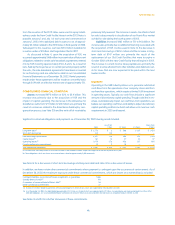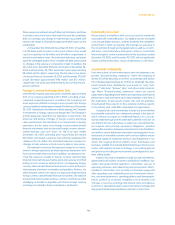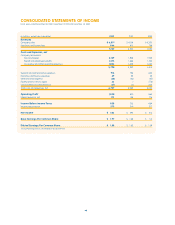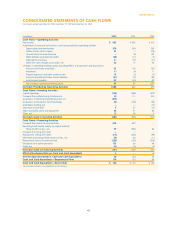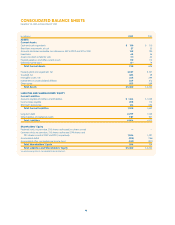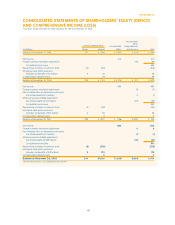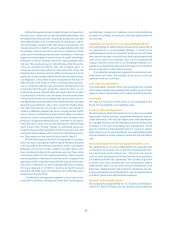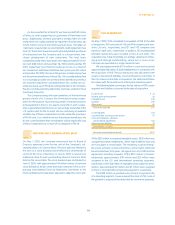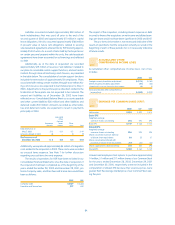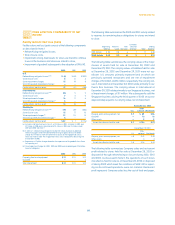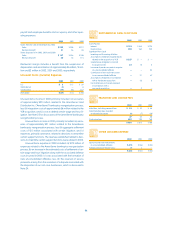Pizza Hut 2002 Annual Report Download - page 53
Download and view the complete annual report
Please find page 53 of the 2002 Pizza Hut annual report below. You can navigate through the pages in the report by either clicking on the pages listed below, or by using the keyword search tool below to find specific information within the annual report.
accounting for all business combinations and modifies the appli-
cation of the purchase accounting method. Goodwill represents
the excess of the cost of a business acquired over the net of the
amounts assigned to assets acquired, including identifiable intan-
gible assets, and liabilities assumed. SFAS 141 specifies criteria to
be used in determining whether intangible assets acquired in a
purchase method business combination must be recognized and
reported separately from goodwill. We base amounts assigned to
goodwill and other identifiable intangible assets on independent
appraisals or internal estimates.
The Company has also adopted SFAS No. 142, “Goodwill and
Other Intangible Assets” (“SFAS 142”). SFAS 142 eliminates the
requirement to amortize goodwill and indefinite-lived intangible
assets, addresses the amortization of intangible assets with a
defined life, and addresses impairment testing and recognition for
goodwill and indefinite-lived intangible assets. SFAS 142 applies
to goodwill and intangible assets arising from transactions com-
pleted both before and after its effective date. As a result of
adopting SFAS 142, we ceased amortization of goodwill and indef-
inite-lived intangible assets beginning December 30, 2001. Prior
to the adoption of SFAS 142, we amortized goodwill on a straight-
line basis up to 20 years and indefinite-lived intangible assets on
a straight-line basis over 3 to 40 years. Amortizable intangible
assets continue to be amortized on a straight-line basis over 3 to
40 years. As discussed above, we suspend amortization on those
intangible assets with a defined life that are allocated to restau-
rants that are held for sale.
In accordance with the requirements of SFAS 142, goodwill
has been assigned to reporting units for purposes of impairment
testing. Our reporting units are our operating segments in the U.S.
(see Note 23) and our business management units internationally
(typically individual countries). Goodwill impairment tests consist
of a comparison of each reporting unit’s fair value with its carry-
ing value. The fair value of a reporting unit is the amount for which
the unit as a whole could be sold in a current transaction between
willing parties. We generally estimate fair value based on dis-
counted cash flows. If the carrying value of a reporting unit
exceeds its fair value, goodwill is written down to its implied fair
value. As required by SFAS 142, we completed transitional impair-
ment tests of goodwill as of December 30, 2001, which indicated
that there was no impairment. We have selected the beginning of
our fourth quarter as the date on which to perform our ongoing
annual impairment test. As a result of the poor performance by
our Pizza Hut France reporting unit from the date of the transitional
impairment test through September 8, 2002 (the beginning of our
fourth quarter), goodwill assigned to that reporting unit of $5 mil-
lion was deemed impaired and written off in the fourth quarter.
See Note 12 for further discussion of SFAS 142.
Stock-Based Employee Compensation
At December 28, 2002, the Company had four stock-based
employee compensation plans in effect, which are described more
fully in Note 18. The Company accounts for those plans under the
recognition and measurement principles of APB Opinion No. 25,
“Accounting for Stock Issued to Employees,” and related
Interpretations. No stock-based employee compensation cost is
reflected in net income, as all options granted under those plans
had an exercise price equal to the market value of the underlying
common stock on the date of grant. The following table illustrates
the effect on net income and earnings per share if the Company
had applied the fair value recognition provisions of SFAS No. 123
“Accounting for Stock-Based Compensation,” to stock-based
employee compensation.
2002 2001 2000
Net Income, as reported $ 583 $ 492 $ 413
Deduct: Total stock-based employee
compensation expense determined
under fair value based method for
all awards, net of related tax effects (39) (37) (34)
Net Income, pro forma 544 455 379
Basic Earnings per Common Share
As reported $1.97 $ 1.68 $ 1.41
Pro forma 1.84 1.55 1.29
Diluted Earnings per Common Share
As reported $ 1.88 $ 1.62 $ 1.39
Pro forma 1.76 1.50 1.29
Derivative Financial Instruments
Our policy prohibits the use of derivative instruments for trading
purposes, and we have procedures in place to monitor and con-
trol their use. Our use of derivative instruments has included
interest rate swaps and collars, treasury locks and foreign cur-
rency forward contracts. In addition, on a limited basis we utilize
commodity futures and options contracts. Our interest rate and
foreign currency derivative contracts are entered into with finan-
cial institutions while our commodity derivative contracts are
exchange traded.
We account for derivative financial instruments in accordance
with SFAS No. 133, “Accounting for Derivative Instruments and
Hedging Activities” (“SFAS 133”). SFAS 133 requires that all deriva-
tive instruments be recorded on the Consolidated Balance Sheet
at fair value. The accounting for changes in the fair value (i.e., gains
or losses) of a derivative instrument is dependent upon whether
the derivative has been designated and qualifies as part of a
hedging relationship and further, on the type of hedging relation-
ship. For derivative instruments that are designated and qualify as
a fair value hedge, the gain or loss on the derivative instrument as
51.
Yum! Brands Inc.


